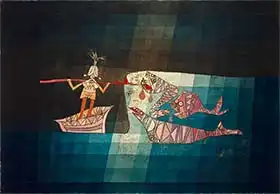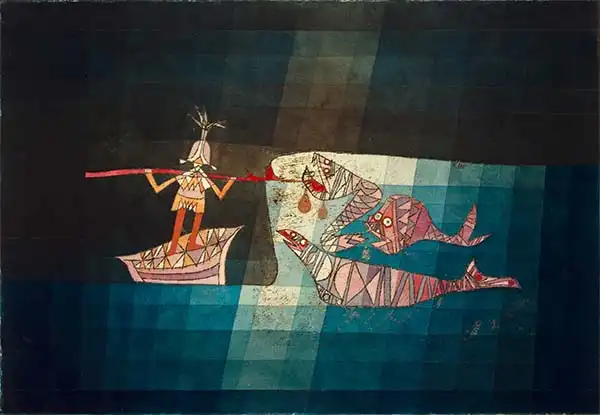About this finishing
Print. The image is printed on the top quality 10-ink HP Z9PS printer on HP matte 270 g / m2 paper. You can choose any size to an accuracy of 1 cm. A margin of 5 cm around the image is added to the size of the motif.


You can find a detailed description about our finishings
here.
War scene from the comic opera The Seafarer
Date:
1923Medium:
oil and watercoloursLocation:
Offentliche Kunstsammlung, Basel, ŠvýcarskoDimensions:
34.5 x 50The painting represents a stylized scene with an Indian standing in a canoe and holding a long oar or spear. Next to him swims a large cartoonish fish creature that has elements of both a fish and a dragon. The work has a geometric character and it is possible to see elements of primitive art or children's drawings in it. The dominant colors are blue, red and white. Overall, the picture has a calm and fairytale atmosphere.
Klee painted picture War scene from the comic opera The Seafarer in 1923. Prevailing color of this fine art print is blue and its shape is landscape. Original size is 34.5 x 50. This art piece is located in Offentliche Kunstsammlung, Basel, Švýcarsko. This image is printed on demand - you can choose material, size and finishing.
Paul Klee (1879-1940). From childhood, he was interested in both music and painting, but as is evident, finally decided on painting - his paintings are among prized artworks. In Munich, he met
Kandinsky, Franz Marc, and other artists of the then avant-garde. He met also his future wife, pianist Lily Stumpf. His work is associated with a
expressionism, cubism, and
surrealism. He was one of the four Die Blaue Vier (with Kandinsky, Feininger and Jawlensky). He taught at Bauhaus and the Düsseldorf Academy until 1933, when the Nazis declared his paintings a figment of a sick soul and with labelled his whole creation as degenerate art. Klee was extremely hardworking and after his death, he left behind 8926 works in Switzerland. Klee’s paintings are fragile, with a sensitive use of color (his colour mixing ranks among the world’s best) and frequent references to poetry, music and dreams.


